
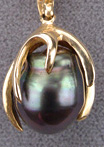
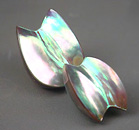
OPTICAL PHENOMENA IN GEMSTONES I initially thought to title this lesson "Phenomenal Gems", but recalling an incident from a few years ago, I opted for the longer title. I was the evening's speaker for a local Rock and Gem Club meeting, and as I was being introduced to folks prior to the meeting, a young boy asked me what I'd be talking about. My reply "Phenomenal Gems", brought a perplexed smile to his face, and the query: "Do you mean really, really, BIG ones?"
Optical phenomena encompass the light-dependent properties of a gem, which are not due to its basic chemical and crystalline structure, but rather, due to the interaction of light with certain inclusions or structural features within the gem.
- Iridescence, including:
- Orient
- Labradorescence
- Play of color
- Adularescence
- Aventurescence
- Chatoyancy, including:
- Simple chatoyancy
- Cat'seye effect
- Asterism
- Color change
**Check the web: Optical phenomena are not limited to gemstones, for a neat overview of other interactions of matter with light (like rainbows and the aurora effects: borealis and australis): go to this URL: http://en.wikipedia.org/wiki/Optical_phenomenon (warning--> you could get stuck here for hours, it's so interesting!)
Iridescence: This phenomenon is seen as a multicolored, surface effect. It is caused by diffraction. As white light passes through very small openings such as pores or slits, or through thin layers of material which differ in refractive index, a prism effect causes it to separate into spectral colors. These may then be seen on the surface, or in some cases in the interior, of the material. Iridescence is responsible for the everyday observations of the spectacular colors seen in the metallically shimmering neck plumage of male Mallard ducks, peacocks and some hummingbirds, or as light catches the surface of a soap bubble.
When combined with interference, where the slightly out of phase color waves bouncing off different layers overlap as they reflect, a loss of some colors and a reinforcement of others can take place giving rise to dramatic color blocks, which may shift with viewing angle.
Iridescence is the most widespread of the optical phenomena, we see its effects in: the "orient" of pearls, the displays of fire agate, "rainbow calcite", certain obsidians, and iris agate. It also creates the rainbow display of fractures, the beautiful colors of Labradorite, and, probably most well known, the "color play" of precious opal.
Pearls: The "orient" of pearls, is a delicate, shifting, iridescent color layer that is distinct from the basic body color of the pearl or from its luster. Both luster and orient are a function of the thickness and perfection of the layer of nacre on the pearl's surface. Nacre is composed of thin plate-like layers of aragonite (CaCO3) crystals accounting for over 90% of its weight, along with conchiolin protein, and water. Although most pearls have that characteristic "pearly luster", only fine quality pearls have orient. It can also be present in the "mother of pearl" lining of shells, and is especially vivid in the shells of some species of abalone.



Fire Agate: The aggregate quartz gem known as fire agate, gets its iridescence from thin coatings of iron oxide (limonite) layered over its botryoidal chalcedony surface. The best specimens of this material can be very striking, and will command some of the highest prices of any aggregate form of quartz.
[Fire agate cabochon in a pendant, a close up view of some fire agate colors] Ammolite: This gem is the result of the fossilization of extinct, shelled mollusks, called ammonites. Although many ammonite fossils are found, only a certain type from a restricted area in Canada shows the iridescent effect, which has preserved, and enhanced, the thin, tablet-like aragonite crystal layering of the shell. Although delicate, and not suitable for some jewelry uses, the gem has many admirers and top quality pieces will fetch high prices.
The thickness of the preserved layers controls the colors that will be seen. Thicker layers produce red or orange colors, and thinner ones, the blues and violets. Due to the fragility of the thinnest layers, specimens with blue or violet color are especially rare and costly.
[A fine specimen with rare blue and violet colors, and one with the more commonly seen red, a 10x view of green, blue and red iridescence on an ammolite] **Check the web: For a tour of one of the World's largest ammolite mines, visit this URL: http://ammolitemine.com/mine_tour.htm
Phenomenal obsidian: Most obsidian is pretty plain looking, in mostly drab shades of brown and black. Certain types, however, display iridescent patterns due to dense congregations of minute suspended inclusions that act like diffraction gratings. Fanciful trade names like "velvet" or "rainbow" obsidian are used to market these lovely gems.
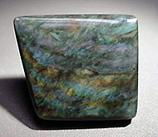

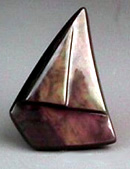
Fractures/Cleavages: As noted in the lesson on magnification, an internal cleavage can give evidence of its presence by a "cleavage rainbow". The picture below, showing impressive iridescence, is a magnified view of a very thin conchoical fracture in a gem.
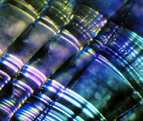
There are other cases, where rather than revealing a defect, the presence of microscopic fractures or cleavages is responsible for the beauty of a particular gem. Two examples which are admired by collectors are known as "rainbow calcite" and "iris quartz".
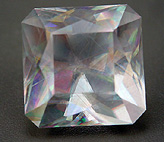
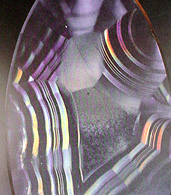
Labradorescence: This phenomenon is a type of iridescence caused by repeated, microscopically thin layer (lamellar) twinning in Labradorite feldspar. One of its most notable characteristics is that the twinning is quite specifically oriented within the crystal, making the iridescent display highly directional. (Another is that it is seen in only this one species.) At some angles the light encounters no thin layers and no effect is seen, in other directions of view we see a bright blue, gold, green or multicolored surface. Looking at the sample of Labradorite rough pieces below you can see that only some of the "faces" are showing color at the angle at which they were photographed.
The finest pieces have strong displays which skilled cutters take care to orient to best advantage for the face-up view. The lovely cabochon pair and brooch below show how bright and attractive the display can be, but if they were turned to a different angle, that beauty would temporarily be lost, only to return again as the pieces were moved in another direction.
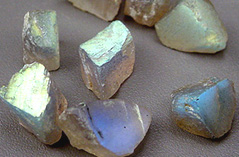

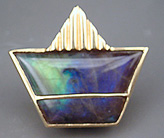
**Check the web: One of the newest sources for attractive Labradorite is in Madagascar: go to this URL to see some of their specimens and a photo of the mine: http://www.madagascarminerals.com/pd_labradorite_rough.cfm
Play of color: Iridescence in precious opal is correctly called "play of color" or "color play". The incorrect term "fire" is often misused instead--> recall from Lesson 4 that "fire" is an acceptable synonym for dispersion. But, at least in this course, it is not an acceptable synonym for "play of color". What is taking place in opals, is not dispersion, but iridescence. We divide all opals (a huge group of gems) into precious and common, based on whether they have color play, or not, respectively.
[Precious opals: black opal:Image courtesy of GIA, precious Mexican opal, white precious opal pendant, matrix opal, "contra luz" opal (a rare type with a different display of colors in reflected versus transmitted light)] Play of color is seen as shifting patches of spectral colors on the gem's surface and/or in its the interior. This phenomenon is caused by the unique ultrastructure of the opal. The graphic below represents an interior view of opal at 25,000X via the electron microscope. Opal is made of spheres of cristobalite silica, SiO2(a polymorph of quartz). These are arrayed in closely stacked layers and have air, or more rarely, liquid, in between them. (To picture something similar on a larger scale, think of a crate of oranges with the fruit neatly arrayed into rows.) The openings act as diffraction gratings which split the light into colors, and the layered structure creates interference. As the light is reflected from the various layers the, now slightly out of sync waves overlap, decreasing or removing certain spectral colors, and reinforcing others. Thus, we get a shifting group of colors which flicker on and off, and move as we twist and turn the gem altering the light path and viewing angle. Which colors are seen is a function of the size and regularity of the spheres (with smaller spheres more blue is seen, with larger ones more red) and of our angle of view.
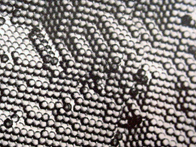
In common opal, the openings between the spheres are so large that light doesn't have to bend when traveling through them, so that no diffraction takes place. Rather, the scattering and bouncing of light off the inner particles creates a sort of hazy effect commonly known as "opalescence". (Actually, opalescence is an example of another phenomenon called adularescence, see below.)

**Check the text: Pg. 222 in Lyman has pictures contrasting common and precious opal as found in the rough.
**Check the web: This website has an in-depth discussion on the cause of color play in opals, with beautiful pictures: http://www.opalsdownunder.com.au/articles/colour
Man-made iridescence: Taking a clue from Nature, humans have deliberately applied thin coatings or films of various kinds to the surfaces of gems to create iridescence. Although fragile, and to some tastes, a bit gaudy, these gems are popular. Two examples are the various iridescent topazes, the most common of which goes by the trade name "Mystic Topaz", and "titanium" drusy. In each case, a natural gem (a topaz or a quartz drusy) is coated with a microscopic layer of material (usually metallic) which creates the effect.
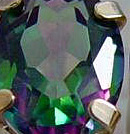
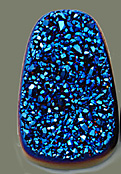
Adularescence: When a gem displays a billowy floating light which appears to come from below the surface it is showing adularescence. The name comes from the most prominent gem displaying the phenomenon: moonstone, known historically as "adularia". The term "shiller" or "schiller" is sometimes used to describe the light.
Moonstone: In moonstone, adularescence is due to a layer effect, where thin inner strata of two types of feldspar intermix, (exsolution regions of sodium feldspar in potassium feldspar). These layers scatter light either equally in all spectral regions producing a white shiller, or as in the most valuable specimens, preferentially in the blue or the blue and orange. As in so many cases of optical phenomena the size or distance from layer to layer influences the colors we see.
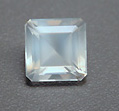
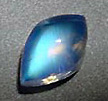

**Check the text: The Hall text, (pg. 123) has a beautiful picture of a blue moonstone cameo-style carving (technically it might be termed a cuvette cameo-->but more about that in Lesson 7)
Adularescence in other species: In other gems, the scattering shows up in a less dramatic form due to minute inclusions that scatter multiple wavelengths of light . In certain quartzes and opals, golden shifting light can be seen in the interior, which is sometimes called the "girasol" effect
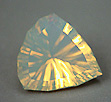
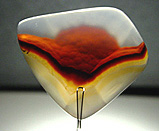
This general scattering of light, often is not distinctive, but rather shows up as subtle haziness, as in the case of the opalescence of common opal. Frequently we see the term "milky" used to describe individual specimens of a usually non-hazy species which show this type of adularescence. An exception is rose quartz which is virtually always hazy, so it doesn't need a special adjective, like milky, to distinguish it.
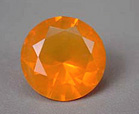

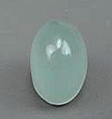
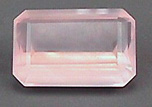
Aventurescence: Unlike the other phenomena discussed so far which owe their beauty and distinctiveness to structural features which diffract or scatter light, aventurescence is a consequence of reflection. When disk or plate-like inclusions of another mineral are present, and are of a highly reflective nature such that they act as tiny mirrors, the gem sparkles and glitters. This glitter is called aventurescence. The term shiller, is also sometimes used to describe this spangly glow. The most common reflectors are copper, hematite and mica.
The name is derived from the Italian word for "chance" or accident, and has no "d" in it! Quite frequently, even among those who should know better (like shopping channel hosts), the word is mispronouced as "adventurine". The most commonly encountered species showing this effect are certain feldspars and one variety of quartz.
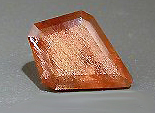

"Goldstone", a man-made aventurescent glass with copper particles deliberately added to it, has been an inexpensive and popular gem imitation since Victorian times, and remains commonly in use today.

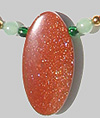
Chatoyancy: This phenomenon is also due to reflection, but in this case, rather than involving plate-like inclusions scattered randomly, it is due to parallel thread-like reflective inclusions such as needles or tubes. When the inclusions are either not highly organized, or the gem is not cut in such a way as to concentrate or focus the light from them, we see a silky glow called simple chatoyance.
Simple chatoyance: Tiger'seye is the most common gem that displays this phenomenon. Most pieces are a yellow to light brown color, but enhancements can create reds or other colors, and a naturally occuring variant called "hawk'seye" has a grey-blue to greenish color.
**Check the text: In the Hall text, pg. 86 are pictures of a cigarette box made of hawk'seye quartz and a piece of hawk'seye rough.
Less familiar to many, but greatly admired for their displays of chatoyance are the purple Charoites and the silvery grey serefinites.
Corundum often contains rutile needles but frequently they are not abundant or organized enough to produce a star gem, and instead show up as a general silky glow, as seen in the ruby and sapphire carvings below.


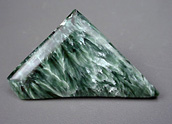
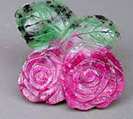
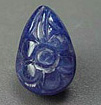
The cat'seye effect: When the reflective fibers that create chatoyancy are aligned within a single crystal axis, and when the gem is properly oriented and cut as a domed cabochon, the reflections concentrate into a single band of light on the dome known as an "eye". Viewing this phenomenon is easiest with a single overhead source of light like sunlight, or a spotlight or penlight, and less successful with multiple light sources, or in dimly lit surrroundings.
The pictures below show a close up of the parallel growth tubes in a rubellite tourmaline and the effect seen in that gem when it is viewed with proper lighting.
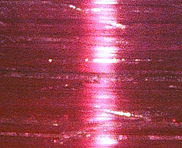

Cat'seye gems have been popular throughout history, especially in the Orient. Cat'seye chrysoberyl is the most valued of all, and it has traditionally been given the honor of simply being called "cat'seye", whereas all other types, technically require a species modifier like: cat'seye tourmaline, cat'seye moonstone, etc.
[Just plain cat'seye (chrysoberyl), cat'seye moonstone] **Check the text: Pg. 76 in Hall shows a cat'seye aquamarine
Fine quality cat'seye gems show some translucency, have a strong, well centered and straight eye and "do tricks". By that I mean:
1) with the light overhead, we see a strong eye
2) by moving the light source to one side and lighting the gem laterally, we get the "milk and honey" effect, (one side light, one side dark)
3) by using two lights and moving them from the center to the side, the eye will split into two bands each of which follows one of the light sources (opening and closing).
These effects are shown in the pictures of the cat'seye (chrysoberyl) gem below:
[Cat'seye tricks: single eye, milk and honey effect, the beginning of the opening and closing effect as the single eye is splitting into two] The most commonly encountered cat'seyes are tourmalines, moonstones, chrysoberyl and quartz. Below is a selection of some gems that are extremely rare in cat'seye form:
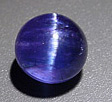

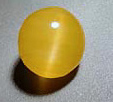
(OK, I'm going to irrevocably date myself with this analogy, but seeing all three of these rare cat'seye gems together at one time is the gemological equivalent of going to a concert where Jimmy Page, Keith Richards and Jeff Beck are all playing guitar on the same stage.)
Asterism: This phenomenon is essentially a special case of the cat'seye effect, where the inclusions responsible for reflections are oriented parallel to more than one axis in the crystal. As with cat'seyes, the stone must be both properly oriented, and cut in a high dome to display the star.
Depending on the nature of the inclusions and the crystal system of the host, a four or six rayed star will generally be displayed. By far, the most common star stone species is corundum, with quartz a distant second. Stars are relatively rare in other species.
**Check the text: Both pgs. 31 & 112 in Lyman have pictures of the second largest star sapphire in the world: "The Star of Asia : 330 cts".

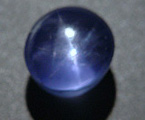


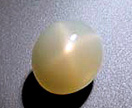
Food for thought: (The answer to this question will be found at the end of this lecture).
Question 1: Cat'seye and star stones are generally used in rings and bracelets, rather than in brooches, tie pins, earrings or pendants. Why do you think this is so?
Color change: A color change gem is one whose color is substantially different when viewed with an incandescent light source as compared to its color as seen under daylight or a daylight equivalent fluorescent source. Due to this phenomenon's strong association with the Alexandrite variety of chrysoberyl, it is sometimes termed the "Alexandrite effect", regardless of which species is displaying it.
**Check the web: I'm not sure how accurate this account may be, as I am no scholar of Russian history, but go to this URL for the most detailed version of the often told "Alexandrite discovery story" that I've ever read: http://created-uniques.com/history/alex.htm
Distinct from pleochroism, where the direction of view causes the color difference, true color change stones do not change color with a shift in viewing axis, but only with a change in light source. Due to their distinctive chemistry, stones which show this effect have very strong selective absorption in those regions of the spectrum where the two light sources differ most (that is, strong absorption in both the red and the blue). Daylight is rich in blues and incandescent sources are rich in reds --> so, although the stone could absorb both strongly, there is little blue in incandescent and little red in daylight to absorb. Hence we get different patterns of selective absorption, and see different colors.
The completeness of the change is usually designated by percentage, for example, we might say that a particular stone shows a 70% color change. Although natural stones rarely show a complete color change, synthetic and simulant color change stones have been made which create the effect very strongly.
In addition to Alexandrite chrysoberyl, other species which are occasionally found in color change forms are: sapphire, spinel, garnet, tourmaline and diaspore.


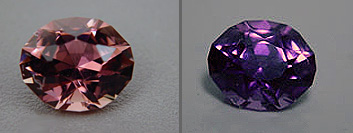

Answer to the thought question for this lesson: (If you don't understand why this is the answer, then it's a good time to email me and ask!)
1) Cat'seye and star stones are oriented in such a way that their phenomena are well displayed on the center of the dome of the cabochon when light is hitting it perpendicular to the base of the cabochon. This is what happens when you hold your hand out to see a ring or bracelet (or when they are viewed in a jewelry display case), but gems that hang or are worn vertically do not show their phenomena to good advantage, as the light is mostly hitting the gem obliquely or parallel to the base.
You have now completed the web lecture for the sixth lesson!
Go back the the course website to: 1) complete and submit the homework assignment on the text readings and assigned web essays 2) take the non-graded practice quiz on this web lecture 3) post a comment to the discussion board for this lesson, and 4) when it is available, complete the graded quiz based on this web lecture.
When you're ready, proceed on to Lesson Seven: Gem Fashioning